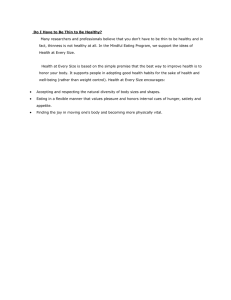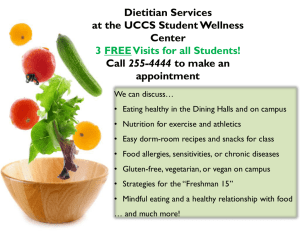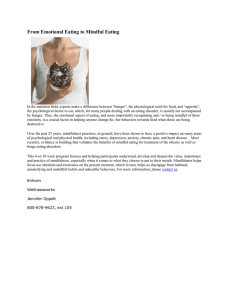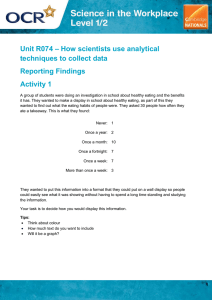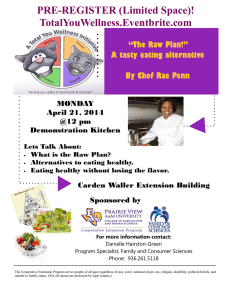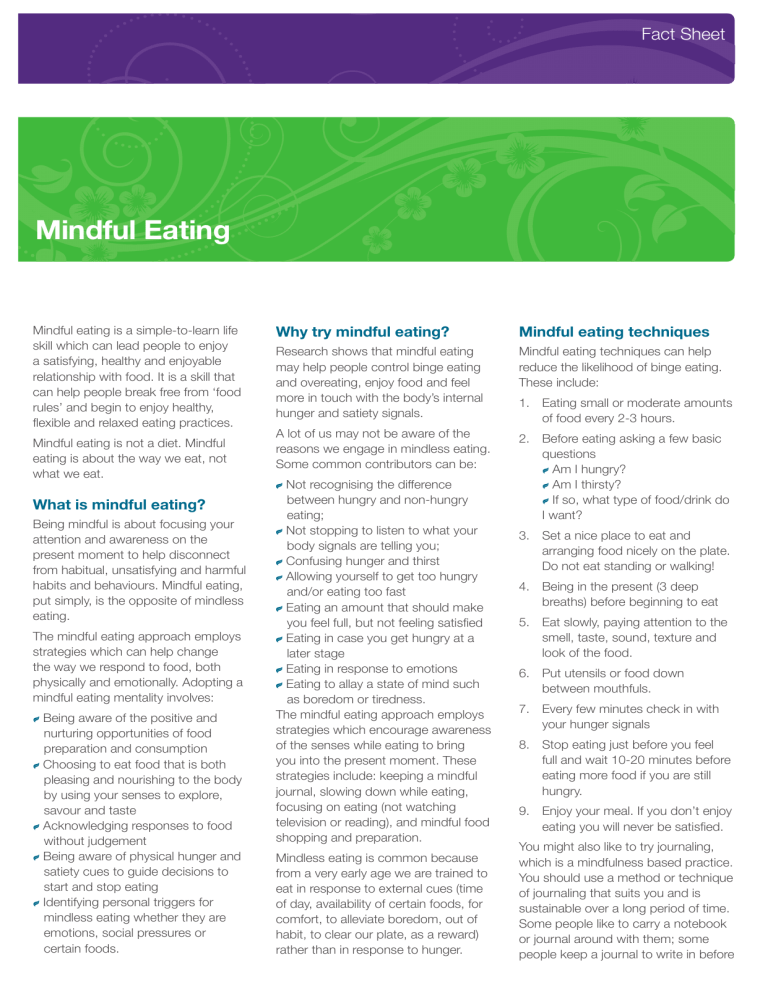
Fact Sheet Mindful Eating Mindful eating is a simple-to-learn life skill which can lead people to enjoy a satisfying, healthy and enjoyable relationship with food. It is a skill that can help people break free from ‘food rules’ and begin to enjoy healthy, flexible and relaxed eating practices. Mindful eating is not a diet. Mindful eating is about the way we eat, not what we eat. What is mindful eating? Being mindful is about focusing your attention and awareness on the present moment to help disconnect from habitual, unsatisfying and harmful habits and behaviours. Mindful eating, put simply, is the opposite of mindless eating. The mindful eating approach employs strategies which can help change the way we respond to food, both physically and emotionally. Adopting a mindful eating mentality involves: Being aware of the positive and nurturing opportunities of food preparation and consumption Choosing to eat food that is both pleasing and nourishing to the body by using your senses to explore, savour and taste Acknowledging responses to food without judgement Being aware of physical hunger and satiety cues to guide decisions to start and stop eating Identifying personal triggers for mindless eating whether they are emotions, social pressures or certain foods. Why try mindful eating? Mindful eating techniques Research shows that mindful eating may help people control binge eating and overeating, enjoy food and feel more in touch with the body’s internal hunger and satiety signals. Mindful eating techniques can help reduce the likelihood of binge eating. These include: A lot of us may not be aware of the reasons we engage in mindless eating. Some common contributors can be: 2. Before eating asking a few basic questions Am I hungry? Am I thirsty? If so, what type of food/drink do I want? Not recognising the difference between hungry and non-hungry eating; Not stopping to listen to what your body signals are telling you; Confusing hunger and thirst Allowing yourself to get too hungry and/or eating too fast Eating an amount that should make you feel full, but not feeling satisfied Eating in case you get hungry at a later stage Eating in response to emotions Eating to allay a state of mind such as boredom or tiredness. The mindful eating approach employs strategies which encourage awareness of the senses while eating to bring you into the present moment. These strategies include: keeping a mindful journal, slowing down while eating, focusing on eating (not watching television or reading), and mindful food shopping and preparation. Mindless eating is common because from a very early age we are trained to eat in response to external cues (time of day, availability of certain foods, for comfort, to alleviate boredom, out of habit, to clear our plate, as a reward) rather than in response to hunger. 1. Eating small or moderate amounts of food every 2-3 hours. 3. Set a nice place to eat and arranging food nicely on the plate. Do not eat standing or walking! 4. Being in the present (3 deep breaths) before beginning to eat 5. Eat slowly, paying attention to the smell, taste, sound, texture and look of the food. 6. Put utensils or food down between mouthfuls. 7. Every few minutes check in with your hunger signals 8. Stop eating just before you feel full and wait 10-20 minutes before eating more food if you are still hungry. 9. Enjoy your meal. If you don’t enjoy eating you will never be satisfied. You might also like to try journaling, which is a mindfulness based practice. You should use a method or technique of journaling that suits you and is sustainable over a long period of time. Some people like to carry a notebook or journal around with them; some people keep a journal to write in before Mindful eating they go to bed. Others keep a food diary or notes on their computer. It doesn’t really matter what you write, it can be a list of foods you ate, a poem, a description of your feelings or a drawing. Yoga, meditation and walking meditation are also mindfulness based activities you might like to try. Here is a simple mindful eating exercise you can do at home to practice the skill of eating mindfully. 1. Choose one piece of food. It might be a raisin, a slice of mandarin, a potato chip or a chocolate. 2. Begin by looking at the food. Examine the shape, colour and texture. 3. Bring the food to your nose and smell it. 4. Place the food on your tongue. Notice the response of your salivary glands. 5. Take a bite and be aware of the sounds in your mouth and the texture on your tongue. 6. Notice how the texture of the food changes as you chew. 7. Now swallow. Pay attention as the food travels down your throat to your stomach. 8. Now say the name of the food silently to yourself. 9. Try practicing a mindful bite at least once every meal. Where do I go for more information? Further information on mindful eating can be found on the following websites: www.eatingdisorders.com.au Eating Disorders Victoria website. Includes dates for upcoming mindful eating workshops. www.eatingmindfully.com This website contains information about mindful eating as well as some good books by Susan Albers www.tcme.org The Center for Mindful Eating (TCME) provides a wide variety of resources and training for those seeking up-todate information about mindful eating practices, research, and education. Five good minutes in your body (Jeffrey Brantley, Wendy Millstine) 100 mindful practices to help you accept yourself and feel at home in your body. Eat, drink and be mindful (Susan Albers) Tips, activities and checklists to help you start a mindful eating program, evaluate your progress and discover a healthier and richer relationship with food. The Camp System - Learning to live in balance and harmony with food (Frederick Burggraf) Control, Attitudes, Mindfulness and Portions (CAMP) system places importance on how to eat rather than what to eat. Eating the moment (Pavel G. Somov) Activities to help you listen to your body, understand why you’re eating and control your cravings if you’re eating out of habit or because of your emotions. Mindless eating (Brian Wansink) Food psychologist Brian Wansink revolutionises our awareness of how much, what and why we’re eating – often without even realising it. Full catastrophe living (Jon KabatZinn) This book shows you how to use natural, medically proven methods to soothe and heal your body, mind and spirit. Recommended reading Eating mindfully (Susan Albers) The key to changing the way you eat is not discipline over what is on your fork, but mastery over your mind. Mindful eating (Jan Chozen Bays) A guide to rediscovering a healthy and joyful relationship with food. Eating Disorders Victoria Level 2, cnr Lulie and Abbot Streets, Abbotsford, Victoria 3067 T 1300 550 236 E help@eatingdisorders.org.au W www.eatingdisorders.org.au Information sheet prepared by Eating Disorders Victoria. The information in this article is by no means intended as a substitute for medical advice from a qualified health practitioner. It does not recommend any one treatment, therapy or medication. Please seek medical advice as different medications suit different individuals. © 2014 Eating Disorders Foundation of Victoria Inc. April 2014 ABN 24 010 832 192 Reg No A0022880J
